This site is made possible by its sponsors.
Please visit them!
mola ![]()
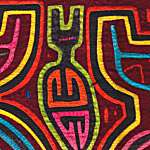 -
A type of appliqué
design traditionally made by the
Cuna Indians, native to the San Blas de Cuna Islands, off the
coast of Panama, in which several layers of cloth are sewn together
and the top layers are cut and turned to show the colors
underneath.
-
A type of appliqué
design traditionally made by the
Cuna Indians, native to the San Blas de Cuna Islands, off the
coast of Panama, in which several layers of cloth are sewn together
and the top layers are cut and turned to show the colors
underneath.
(pr. MOH-lə)
Related links:
Also see textile.
mold [American spelling] or mould [British spelling] - A hollow form for shaping (casting ) a fluid or plastic medium, such as clay, plaster, plastic or molten metal. In papermaking, the lower screen that holds the pulp (the upper frame is a deckle).
Also see core, gelatin, hollow casting, investment, latex, lost-wax casting, mother mold, polyurethane, release agent, and silicone rubber.
molding [American spelling] or moulding [British
spelling] - A strip that adds variety
and interest to a surface
by creating areas of light and shadow, as in a frame. In architecture,
any of various long, narrow, ornamental
bands having a distinctive profile (plain or ornamented) which
project or recede from the surface of a structure.
Its purpose may be to break up a surface, to organize it, to accent it, or to decorate
it. Brunelleschi (Italian, 1377-1446) used dark moldings along
with pilasters and columns
to divide and organize the flat
white walls inside the Pazzi Chapel.

The wood (or other material) assembled to form a painting's stretcher and its frame are also called moldings. These moldings must be mitered so that their corners are right angles.
Also see bevel, boss, chamfer, edge, kerf, ogee, profile, and relief.
mold release - See release agent.
Momoyama - A period in Japanese art history from 1490-1573. It was preceded by the Sengoku Jidai period (1490-1573) and followed by the Edo/Tokugawa period (1615-1868).
Examples of Momoyama period art:

Japan, Helmet (Zukinnari Kabuto), 16th century,
Momoyama period, lacquered
iron, height
16 1/8 inches (41 cm), Metropolitan Museum of Art, NY.

Japan, Stationery
box, Momoyama period (1568-1615), early 17th century,
lacquer, with sprinkled gold decoration
in Kodai-ji style, inlaid
with gold and silver foil,
height 8 1/4 inches (21 cm),
width 17 15/16 inches (45.6
cm), Metropolitan Museum of Art, NY.

Japan, Ewer for use in tea ceremony, Momoyama
period (1568-1615), early 17th century, stoneware with overglaze enamels (Shino-Oribe ware), height
7 3/4 inches (19.7 cm), Metropolitan Museum of Art, NY.
![]()
A Painter ot the Kano School, (Japanese,
active 1596-1614), Falcon on Oak Tree Watching Monkeys,
six-panel folding screen; ink
and light color on paper;
no signature; interpolated jar-shaped
kuninobu seal of Kano Eitoku
(1543-90), Worcester Art Museum, MA.
monastery - A dwelling place of persons under religious vows.
(pr. MAH-nə-STə-ree)
Also see illumination, manuscript, medieval, miniatures, monasticism, and scriptorium.
monasticism - Refers to a way of life in which individuals voluntarily join together in isolated communities called monasteries where they spend their days in prayer, manual labor and self-denial.
Also see historiated, illumination, manuscript, medieval, miniatures, and scriptorium.
monetary value or monetary worth - The price (not to be confused with the art term value) that an art object, writing, intellectual property, etc., might bring in the market place. Buyers and sellers need good information in order to know what could be a high, low, or fair price to pay or ask for something, in order to appropriately insure it, or out of simple curiosity. Monetary value can be determined to varying degrees of reliability by an appraisal, or by offering it for sale either via auction or gallery (traditional or online), or by an advertisement placed in a newspaper or magazine. [A much more in-depth article on this subject is coming soon.]
About the buying and selling of art:
Internet resources concerned with monetary value:
Also see Artist PensionTrust (APT), bad-debt art, commission, commodity, and numismatics.
monitor - In computer
activities, a device that accepts video
signals from a computer, and displays images
and text on a screen
as they are generated by the computer. [Chances are good you're
looking at one right now!] Or, a video screen used to check the
signal being captured by a camera
or being broadcast. Or, more generally, to monitor is to check,
watch, or keep track of. Artists,
for instance, might monitor the activities of collaborators,
or the firing of a kiln,
or the curing of a mold;
art educators monitor their students'
achievements.
images
and text on a screen
as they are generated by the computer. [Chances are good you're
looking at one right now!] Or, a video screen used to check the
signal being captured by a camera
or being broadcast. Or, more generally, to monitor is to check,
watch, or keep track of. Artists,
for instance, might monitor the activities of collaborators,
or the firing of a kiln,
or the curing of a mold;
art educators monitor their students'
achievements.
Also see aspect ratio, assessment, backlight, camcorder, digital image, DPI, full-screen image, graphic design, icon, pixel, terminal, and WYSIWYG.
monochromatic - Consisting of only a single color or hue; may include its tints and shades.
See the article about "monochrome" to see more.
Examples:
Andrea Mantegna (Italian, 1431-1506), The Judgment of Solomon, c. 1490-1500, tempera on canvas, 0.465 x 0.370 m, Louvre. See grisaille and Renaissance.

James Duffield Harding (English, 1797 or
98 - 1863), Twickenham, 1839, drawing and monochromatic watercolor on paper,
27.0 x 38.4 cm, Tate Gallery, London.
Also see analogous colors, camaïeu, color scheme, complementary colors, grisaille, monochrome, split complementary, and triadic colors.
monogram - A design composed of one or more letters, typically the initials of a name, used as an identifying mark. Many artists have signed their work with a monogram rather than their entire name.
Examples:
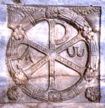
Roman, Chi-Rho, marble
relief, Vatican
Museum. The Chi-Rho is the traditional
monogram or symbol for Christ. Also
called the Christogram or Chrismon, it is comprised of the Greek
letters chi (X) and rho (R), which together form an abbreviation
of the name of Christ. it is often embroidered
onto vestments and altar
cloths, chalices, patens,
and other objects used in
Christian worship. Sometimes, as in this example, it is accompanied
by the first and last letters in the Greek alphabet, alpha and
omega, signifying Christ as the beginning and the end.

![]()

Perhaps the most famous monogram of any artist
is that of Albrecht Dürer (German, 1471-1528). He used it
frequently as his signature on
his works. The detail on the left is from the lower-left corner of the engraving Knight, Death, and the Devil, Dürer
placed his monogram and
 the date within a cartouche.
See Northern
Renaissance.
the date within a cartouche.
See Northern
Renaissance.
Albrecht Dürer, The
Dürer Coat of Arms, 1524, engraving. Dürer's monogram can
be seen at the top center of his coat
of arms.
France, the monogram of the French king Louis XIV (1638-1715) as carved on the exterior masonry of the Louvre, Paris. Now the central museum of France's national collections of art, the Louvre was originally the king's Parisian residence.
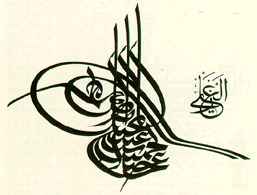
Turkey, the monogram of the Ottoman Sultan Abdu Hamid.
In Turkey, a monogram or insignia is called a tughra.
The three elongated vertical strokes are characteristic of a
style of calligraphy called diwani (derived from the word diwan,
meaning state council or government office) since it was at first
used primarily for documents issued by the Ottoman Council of
State. It is an extremely graceful and very decorative script,
with strong diagonal flourishes, though less easy to read than
some other arabic styles. After its development in Turkey, it
spread to the Arab countries and is in use today for formal documents
and also as architectural decoration.
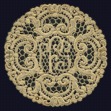
French?, Lace Medallion, late 19th century, "point
de France" style needlepoint,
monogrammed FGP, diameter
61/2 inches (16.5 cm), Marla Mallett collection, Atlanta, GA. See
textile and
medallion.

American, Artisan Embroidery Company, San Carlos, CA,
GSJ,
1994, monogram of initial letters
and leaves embroidered on a pink
cotton towel. This work earned its maker a first place award
in Stitches Magazine's annual Stitch-Off Competition of
1994.
Related links:
SignatureHelp.com offers a database containing "the world's largest collection of signatures and monograms." Find more than 64,500 artists from around the world with 142,000 signature examples represented in picture file format. The database's signatures are from paintings from the 14th century to the present day. To a lesser degree the signatures are from sculptures, watercolors and prints (lithographs, graphics). The database is updated every week with new monograms and signatures. With signaturehelp.com you only have to be able to read one or two letters in the signature or monogram, and a search result will come up with a string of suggestions as to the correct signature. Search an illegible monogram as you read it. A search result will first show a preview with small icons / files. The icons will instantly enable you to see all the suggested results, thus saving you a lot of time by clicking on several names to find the correct signature. You can search the artists without signing up, but you cannot view the picture files.
Also see coat of arms, heraldry, letterhead, logo, and typography.
monograph - A nonfiction book on a specific, often limited subject; most likely about the work of one artist.
monolith - A stone, either decorated or not decorated, erected as a single slab or shaft.
Also see cairn, colossus and colossal, commemorate, cromlech, dolmen, megalith, memorial, monument, obelisk, Seven Wonders of the Ancient World, and Stone Age.
monoprint - One of a series of prints in which each has some differences of color, design, texture, etc. applied to an underlying common image. Not to be confused with a monotype.
monotony, monotonous - Monotony is the state or quality of unpleasantly lacking variety. Also see homogeneity, interesting, obsession, pattern, and unity.
monotype - A one-of-a-kind print made by painting on a smooth metal, glass or stone plate and then printing on paper. The pressure of printing creates a texture not possible when painting directly on paper. Not to be confused with a monoprint.
Examples:
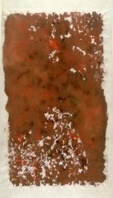
Mark Tobey (American , 1890-1976), Untitled, monotype, 1961, image 50.1
x 30.9 cm, Fine Arts Museums of San Francisco, CA. See Abstract Expressionism.

Antoni Tapies (Spanish, 1923-), Blanche Tendue et Graphisme Noire (White with
Black Marks), 1974, monotype, 140 x 95 cm, Tehran Museum
of Contemporary Art, Iran.
montage - A single pictorial composition made by juxtaposing or overlapping many pictures or designs. The art or process of making such a composition. Also, a rapid succession of different images or shots in a movie.
(pr. mahn-TAHZH)
Examples:

American, Montage of portraits of Charles A. Lindbergh,
1927, Smithsonian Institution, Washington, DC. Lindbergh was
widely regarded as a hero for having been the first to fly solo
across the Atlantic from the US to France in 1927.

American, Montage of New York images following the attacks
of September 11, 2001, 2002, Library of Congress, Washington, DC. This
is a montage digitally produced from documentary photographs.
Also see bricolage, collage, coulage, découpage, femmage, frottage, fumage, parsemage, pasteup, and photomontage.
monumental - In art criticism, any work of art of grandeur and simplicity, regardless of its size, although it often connotes great size.
Also see colossus and colossal and Seven Wonders of the Ancient World.
mood - An overall feeling or emotion, often equated with expression.
mordant
- In etching, a bath of either an
acid or a diluted acid in which
a plate or a piece of glass to be etched is placed.
Also see aqua fortis and nitric acid.
mordant gilding - Oil gilding.
moriage - In Japanese art, forming patterns in raised gesso.
morphing - See metamorphosis.
![]()

![]()
mortar - An adhesive material used in construction, especially a mixture of cement or lime with sand and water.
A "mortar" can also
be a sturdy
bowl in which substances can be crushed or ground
with a pestle. Before many
artists' materials
were manufactured and made commercially
available, artists and their assistants produced paints
and other media from raw materials,
grinding many of them to prepare colorants,
binders, glazes,
investments, etc.
People in the visual arts still use these tools.
Sometimes, when containers of ceramic glazes are unused for a while, the water in them evaporates, leaving other ingredients dried into very hard, compact chunks of powder. Unfortunately, simply adding water doesn't soften this stuff, and throwing such valuable ingredients away is wasteful. Conserve this material by breaking pieces into ever smaller and smaller sizes. A hammer and an old chisel can accomplish the first phase of this work. Complete the process by crushing and grinding small pieces with a mortar and pestle. Add water, and that old glaze is as good as new.
Also see adobe, aggregate, binder, concrete, cure, grout, join, masonry, nails, mosaic, stone, tile, and vessel.
![]()

![]() mortise
or mortice - A cavity in a material
(usually wood, but sometimes stone or metal)
into which a tenon is made to
fit in order to create a joint.
Mortises are usually rectangular
or trapezoidal in shape.
Also, to make such a cavity or to join
pieces of material with them. "Mortice" is an alternative
spelling.
mortise
or mortice - A cavity in a material
(usually wood, but sometimes stone or metal)
into which a tenon is made to
fit in order to create a joint.
Mortises are usually rectangular
or trapezoidal in shape.
Also, to make such a cavity or to join
pieces of material with them. "Mortice" is an alternative
spelling.
mosque - An Islamic place of worship. "Mosque" is a French word, an adaptation of the Arabic word masjid, meaning a place of prostration. A mosques which is also partly a school might be called a madrasa. Mosques can also be meeting places for military, political, judicial, and purely social purposes in Islamic communities.
Also see architecture, dikka, mihrab, minaret, minbar, and qiblah.
mother mold - In casting, a mold outside of another mold. It is a support shell that helps to hold the shape of a rubber or latex mold. A mother mold is generally composed of two pieces which surround the sections of a piece mold. It must be made of a rigid material such as fiberglass or plaster. Sometimes called main case.
Also see foundry and lost-wax casting.
![]()
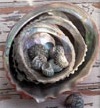
![]() mother-of-pearl - The pearly, iridescent
internal layer of certain mollusk shells, used as an inlay
or veneer in jewelry,
furniture, and other
decorative objects.
"Interference" caused by small surface grooves on the
surface — minute striations
on thin layers of chitin — results in an apparent bending of
light. Thin film interference causes
the coloration. The colors displayed
are dependent on the thickness of the layer of chitin or its index
of refraction.
mother-of-pearl - The pearly, iridescent
internal layer of certain mollusk shells, used as an inlay
or veneer in jewelry,
furniture, and other
decorative objects.
"Interference" caused by small surface grooves on the
surface — minute striations
on thin layers of chitin — results in an apparent bending of
light. Thin film interference causes
the coloration. The colors displayed
are dependent on the thickness of the layer of chitin or its index
of refraction.
Also see intarsia, marquetry, and mosaic.
motif - A consistent or recurrent conceptual element, usually a figure or design. In an architectural or decorative pattern, a motif is employed as the central element in a work, or it is repeated either consistently or as a theme with variations.
(pr. moh-TEEF)
Also see tessellation.
motion - Movement.
mottling - The appearance of spots or blotches of color in paint or on paper.
mould [British spelling] or mold [American spelling] - A hollow form for shaping (casting) a fluid or plastic medium, such as clay, plaster, plastic, or molten metal. In papermaking, the lower screen that holds the pulp (the upper frame is a deckle).
Also see investment, laid paper, lost-wax casting, molding, and wove paper.
mount - To attach securely to a support, as when an artwork on paper is affixed to a sheet of cardboard or another flat and rigid material. Or, to place one or more works in an appropriate site for display, as when a gallery mounts an exhibition. Or the object onto which something is affixed for display. It may be important to choose materials and techniques that are archival (acid-free) and either permanent or reversible.
If an actual animal is mounted, the outermost parts of its body are prepared by taxidermy to present a permanently lifelike appearance.
Examples of mounts:

Camille Pissarro (French, 1830-1903), Fan Mount: The Cabbage Gatherers, gouache on silk, 6 1/2
x 20 1/2 inches (16.5 x 52.1 cm), Metropolitan Museum of Art,
NY. The shape of the fan
mount consists of the area of the picture,
and does not include any of the flat gray areas. See Impressionism.
Paul Klee (German, 1879-1940), Birds Making Scientific Experiments in Sex, pen and black ink on paper mounted on cardboard, signed and dated 1915 and numbered 28 on the mount, 7 6/16 x 4 5/8 inches (18.8 x 11.9 cm), Michael C. Carlos Museum.
Also see art conservation, bristol board, card stock, corrugated cardboard, dry mount, fan, foam core, frame, mat, museum, oaktag, preparator, site-specific, and tip.
 movable type - In printing,
type, such that each character
is cast on a separate piece
of metal. Johan (or Johannes)
Gutenberg (German, c. 1400 - c. 1468) is generally credited with
the invention of movable type. Also spelled moveable.
movable type - In printing,
type, such that each character
is cast on a separate piece
of metal. Johan (or Johannes)
Gutenberg (German, c. 1400 - c. 1468) is generally credited with
the invention of movable type. Also spelled moveable. This is a modern recreation of Gutenberg's type.
Example:

Johan Gutenberg, Mazarin Bible, c. 1455. The first book Gutenberg printed with
movable type is believed to be his Mazarin Bible. This is Volume One (of two), The Old Testament, open to the Book of Judges, pages 114 verso and 115 recto.
Related links:
Also see bookplate and incunabulum.
MP - Abbreviation of the print term monoprint.
MPEG - Motion Picture Experts Group. Used to refer to an image compression scheme for motion-picture video they developed. MPEG takes advantage of the fact that full-motion video is made up of many successive frames, often consisting of large areas that don't change, such as blue sky background. MPEG "differencing" notes differences, or lack of them, from one frame to the next.
Also see digital imaging.
MSDS - See Material Safety Data Sheet (MSDS).
MT - Abbreviation of the print term monotype.
![]()

![]()
mucilage - Gum or any viscous substance derived from plants. May refer to a type of adhesive made with such ingredients.
(pr. MYOO-sə-lədj)
Also see gum arabic or gum acacia.
mudra - In Hinduism, a stylized gesture of mystical significance, usually in representations of Hindu deities.
Mughal dynasty or Mugal dynasty
![]()
![]()

![]()
mullion - A thin member that divides a window or that separates one window from another. Usually mullions are vertical, but they can also be horizontal, diagonal, and curved.
(pr. MUL-yən)
Also see architecture, came, fenestration, frame, glass, lunette, and molding.
multiculturalism - A movement to broaden the range of cultures we study, in contrast to the prevailing (traditional ethnocentric and racist) opinion that the great accomplishments have been made almost exclusively by males of European descent (DWMs). Multiculturalism urges people of every culture to assess the qualities of other cultures through the lens of their own.
Problems can arise when situating all non-dominant cultures as "other," since this perpetuates the relationship of us-and-them. Another problem is multiculturalism's tendency to freeze cultures at an immigrant stage of development.
Also see African American art, art therapy, chinoiserie, ethnic, ethnocentrism, ethnosphere, feminism and feminist art, humanism, isms and -ism, orientalism, political correctness, xenophilia, and xenophobia.
multimedia - In personal computing, software and applications that combine text, high quality sound, graphics, and animation or video.
Resources on the Internet concerning multimedia:
Also see mixed media and new media.
multiple - More than one of the same object or subject. Sometimes meant as an equivalent to edition, the term traditionally preferred by makers of prints and cast sculptures.
David Hockney calls his photocollages "multiples."
Example:

David Hockney (English, lives and works in
USA, 1937-), Portrait
of the Artist's Mother, c. 1985?, photocollage. This
is called a photocollage rather than a photomontage,
because it is more three-dimensional
than a montage tends to be. Hockney reflected extensively on
his process of collaging prints taken with a 35 mm camera as connecting to the Cubist sense of multiple angles
and especially of movement.
These "multiples" (as he called them) convey a strong
sense of movement, Hockney argued, in that the viewer must keep
readjusting his imagined viewpoint as his gaze travels from print
to print. And of course by this means the viewer builds up a
single image that is many times wider in angle of view than the
camera lens. (The viewing
angle of a standard 55mm lens for a 35mm format camera is about
45 degrees. Wide angle lenses increase the angle of view to about
75 degrees without obvious distortion, but the human angle of
view, with eye movement, is about 180 degrees.) This portrait
of Hockney's mother illustrates the technique
at close range. See collage.
multiple intelligence theory - A set of theories about how people learn in a variety of ways. Howard Gardner (American, 1943-), a professor at the Harvard Graduate School of Education, developed and introduced the theory of multiple intelligences in his 1983 book Frames of Mind. Gardner proposes that there is not a single "intelligence" but rather that there are eight (some call these "learning styles"):
Those who recognize the importance of multiple intelligences believe that because students tend to be stronger in one or more of these cognitive skills, and weaker in others, educators need to provide opportunities for students to learn in each of the intelligences. Art educational activities should be developing "Visual / Spatial Intelligence." Some students of visual art may approach it most effectively through experiences involving the use of the intelligences in which they are stronger. Since many students have highly developed their verbal intelligence abilities, ArtPage can provide an excellent means for the growth of their visual / spatial intelligence.
Since the middle 1980s, Howard Gardner has been heavily involved in school reform efforts in the United States. He has also been highly involved with Project Zero, a research group in human cognition that maintains a special focus on the arts. More recently, his research is focusing on the GoodWork Project. "GoodWork" is work that is both excellent in quality and also exhibits a sense of responsibility with respect to implications and applications. Researchers are examining how individuals who wish to carry out good work succeed in doing so during a time when conditions are changing very quickly, market forces are very powerful, and our sense of time and space is being radically altered by technologies such as the Web.
Related link:
Also see achievement, advocacy, attention, Bloom's Taxonomy, communication, dance, effort, genius, interdisciplinary, knowledge, mathematics and art, music, science and art, Stages of Artistic Development, and theater.
Munich Secession - See secession
multisensory - Involving several or all senses.
Also see interdisciplinary and motivation.
Muromachi / Ashikaga - A period in Japanese art history from 1392 - 1573. It was preceded by the Kamakura period (1185-1333) and followed by the Sengoku Jidai period (1490-1573) and the Momoyama period (1573-1615).
Examples of Muromachi/Ashikaga art:
![]()

Japan, Kinkaku-ji (Golden Pavilion), 1397.
![]()
Japanese, Long sword (katana) inscribed by
Sukemitsu of Bizen (Japanese), Short sword (wakizashi) attributed
to Yasumitsu (Japanese), Blades for a Pair of Swords (Daisho);
long sword: dated 1440, short sword 15th century, Muromachi period, steel;
Short sword (wakizashi): 20 3/4 inches (52.1 cm); Long sword
(katana): 25 1/4 inches (64.3 cm), Metropolitan Museum of Art,
NY. See arms
and armor.

Japan, Storage jar, Shigaraki ware, Muromachi
period (1392-1573), 14th-15th century, stoneware with natural ash glaze,
18 3/8 x 15 1/2 inches (46.7 x 39.4 cm), Metropolitan Museum
of Art, NY. See wabi-sabi.
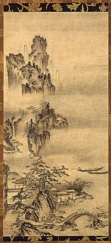
Sokan (Japanese, 16th century), Mountain Landscape, Muromachi period, mid-16th century, hanging scroll, ink and color on paper, 32 3/4 x 15 3/8 inches (83.2 x 39.1 cm), Los Angeles County Museum of Art. See landscape.
murrina - See millefiori.
muse and muses - Generally, a guiding spirit or source of inspiration. In Greek mythology, the nine patron goddesses of the arts; daughters of Zeus (principal god of the Greek pantheon, ruler of the heavens) and Mnemosyne (a titan who personified memory.) They were: Calliope (muse of epic or heroic poetry and eloquence), Euterpe (muse of music and lyric poetry; her attribute the flute), Erato (muse of love poetry), Polyhymnia (muse of oratory or sacred poetry), Clio (muse of history), Melpomene (muse of tragedy), Thalia (or Talia, muse of comedy), Terpsichore (muse of choral song and dance), and Urania (muse of astronomy). They are led by Apollo as god of music and poetry, and Mt. Parnassus is their home. From the word "muse" the words music, museum, and mosaic were derived.
(pr. myooz, MYOO-zəz)
Example images of muses:
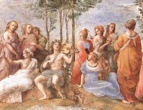
Raphael (Raffaello Sanzio) (Italian, 1483-1520), central group in Parnassus, 1508-1511, fresco, Stanza della Segnatura, Vatican. Sitting (left to right) in this detail: Calliope, Apollo, and Terpsichore; standing: Thalia, Clio, Euterpe, Urania, Melpomene, Polyhymnia, and Erato.

Paul Manship (American, 1886-1966), Lyric Muse, 1912, bronze, National Museum of American
Art, Washington, D.C. See Art
Deco.
Saul Steinberg (American, born Romania, 1914-1999), The painter's muse brings flowers, a cartoon drawing, pen and ink on paper, published in The New Yorker Magazine.
Quote:
Also see art history, brainstorming, creativity, effort, erotica and erotic art, knowledge, motivation, originality, and theater.
museology - The discipline of museum design, organization, and management. Also see art conservation, collection, curator, director, docent, exhibit and exhibition, patron, patronage, preparator, and registrar.
museum preparator - See preparator.
music - Among all the arts, this is the art of arranging sounds in time, resulting in a composition that elicits an aesthetic response in the listener.
Visual art about music:
Egypt, c. 2400 BCE (5th Dynasty), Musicians, detail of the Akhthetep Mastaba from Sakkara, painted limestone bas-relief, Louvre.
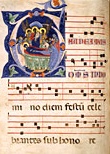
Gerona Bible Master, Bologna, Italy, Gradual,
Proper and Common of Saints (folio
84 verso in Manuscript
526), c. 1285, tempera on vellum,
one of 290 folios, 51.5 x
35.5 cm (20 1/4 x 14 inches), Musei Civici d'Arte Antica, Bologna.
Black marks arranged on the horizontal
lines ("staff")
displayed here exemplify the system of musical notation used
in Italy during much of the Middle
Ages. The Latin text
(or lyric) opens with "Gaudeamus," meaning "Let
us rejoice." The initial letter "G" is historiated
in late Byzantine
style. This "gradual" is
one of a set of three that together comprise the sung portions
of the Mass for the entire church year.
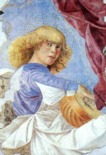
Melozzo Da Forli (Italian, 1438-1494), Music-Making Angel (Angel with a Lute),
fresco, c. 1480, Vatican,
Italy. See angel.
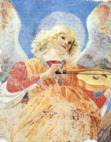
Melozzo Da Forli, Music-Making Angel (Angel with a Violin),
fresco, c. 1480, Vatican,
Italy.
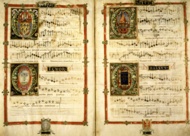
Italian, 16th century, Illumination of "Conditor alme siderum",
a Renaissance
period hymn composed by Costanzo Festa (Italian, c. 1480-1545),
c. 1538, Collection of Polyphonic Hymns and Magnificats, Vatican,
Rome. Costanzo Festa served as a singer in the papal choir from
1517 until his death in 1545. Students of musical notation can
observe developments in that aspect of the work. The arms of
the reigning pope Paul III on the elaborately decorated "Q"
in the upper left. The coat of
arms at the bottom of the right-hand page — lions holding
a wreath with a fleur-de-lis — may be the composer's personal
coat of arms. This work is catalogued as "Capp. Sist. 18
fols. 3 verso - 4 recto
music06 NB.36" See historiated.
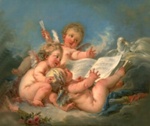
François Boucher (French, 1703-1770), Allegory of Music, 1752, oil on canvas, 26 1/2 x 30 inches (67.3 x 76.2 cm), North Carolina Art Museum, Raleigh. See allegory and Rococo.
Henri Matisse (French, 1869-1954), Music (Sketch) (La Musique [esquisse]), June-July 1907, oil and charcoal on canvas, 29 x 24 inches (73.4 x 60.8 cm), Museum of Modern Art, NY. See dance, Fauvism, movement, and rhythm.
Henri Matisse, Dance (first version), 1909, oil on canvas, 8 feet 6 1/2 inches x 12 feet 9 1/2 inches (259.7 x 390.1 cm), Museum of Modern Art, NY. Matisse painted a second version of Dance in 1910, oil on canvas, 102 x 154 inches (260 x 391 cm), Hermitage Museum, St. Petersburg, Russia. Dance, together with Music, was commissioned by S.I.Shchukin to decorate the staircase in his Moscow mansion. Matisse took the motif of the round dance, used as a symbol back as far as French Renaissance, to represent the rhythm and expression of the 20th century. The spaciousness and expressive lines emphasize the dynamics of the figures. Simplified and schematic forms intensify the brightness and resonance of the three colors -- red, blue and green. Dance, Matisse once said, meant "life and rhythm."
Paul Klee (Swiss, 1879-1940), Twittering Machine, 1922, watercolor and pen and ink on oil transfer drawing on paper, mounted on cardboard, 25 1/4 x 19 inches (63.8 x 48.1 cm), Museum of Modern Art, NY. Klee, who played the violin well, said the music of J. S. Bach and W. A. Mozart greatly influenced his painting. Many of his paintings have in turn inspired musical compositions. Twittering Machine has been cited as inspiring several. See Bauhaus.
Pablo Picasso (born Pablo Ruiz-Picasso) (Spanish, 1881-1973), Guitar, after March 31, 1913, collaged paper, charcoal, ink, and chalk on blue paper, mounted on ragboard, 26 1/8 x 19 1/2 inches (66.4 x 49.6 cm), Museum of Modern Art, NY.
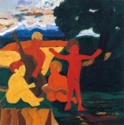
Bob Thompson (American, 1937-1966), Music Lesson, 1962, oil on canvas. See African American art, Fauvism, and Neoclassicism.
Quote:
Also see abstraction, aleatory, animation, Apollo, arts advocacy, arts center, audio guide, auditory, automaton, cinema, creativity, dance, dissonance, eurythmy, four-dimensional, funk art, harmonic sequence, interdisciplinary, juxtaposition, kinesthetic, kinetic, measure, movement, muses, new media, pattern, periodicity, permanence, principles of design, rhythm, theater, theory, universal artwork, and video.
mutable - Subject to change.
Also see time.
mutule - The modillion (projecting bracket) placed in series under the corona of the cornice in the Corinthian, composite, and Roman Ionic order; a projection upon the soffit in the Ionic order.
mystery - Something not understood or beyond reasoning, and therefore exciting curiosity and wonder. Synonyms include: enigma, problem, riddle, puzzle, secret, and paradox.
In Christian tradition, a mystery is a supernatural truth knowable only by revelation — that which cannot be fully understood. Or, a ceremony to which only the initiated are admitted.
"Mystery" also has an archaic, now obsolete meaning: a guild, as of artisans or merchants. In the Latin of the Middle Ages, mysterium was a craft-guild, an alteration of the Late Latin ministerium, occupation, from minister, assistant, servant.
Quote:
Also see beauty, chinoiserie, fantasy, genius, interdisciplinary, knowledge, meaning, mind, motivation, oneiric, Romanticism, sublime, Surrealism, and Symbolism.
myth - A traditional, typically ancient story dealing with supernatural beings, ancestors, or heroes that serves as a fundamental type in the world view of a people, as by explaining aspects of the natural world or delineating the psychology, customs, or ideals of society.
(pr. mith)
Also see attribute, Greek art, mythology, narrative art, and Roman art.
https://inform.quest/_art